BY JINGO - Colonial History & Wargames Page
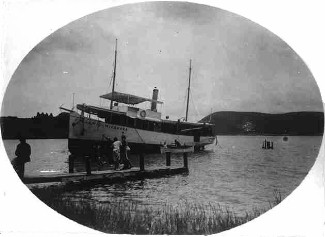
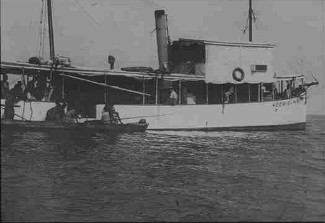
TANGANJIKASEE
A Gunboat War in Deutsch-Ostafrika
1914 - 1916
By Dennis L. Bishop and Holger Dobold
By mid-August, 1914, the situation in the western part of Deutsch-OstAfrika was desperate for the Germans as 11th FK (Kissenji), 9th FK (Usumbura) and 6th FK (Udjidji) were withdrawn to the coast. The German garrisons were five Europeans, 47 polizei askari, and a machinegun at Kisenyi, one European and 25 polizei askari at Chivitoke (on the Russisi River), and 18 Europeans, 80 polizei askari, and one machinegun at Usumbara. In the words of one of the European commanders, ". . . As soon as the Belgians discover that we have very weak forces in Ruanda and Urundi, they will cross the Russisi, and we shall not be able to prevent them."
The source of the German's anxiety was that the western border of the German colony was opposed by 360 Belgian askari at Ruchuru, 190 Belgian askari at Bobandena, 50 Belgian askari at Kwijwa, 325 Belgian askari at Nya Lukemba, and 375 Belgian askari at Uvira from the Compagnie du Kivu. These garrisons stretched from Lake Edward to the northern end of Lake Tanganyika. In addition, the 90-ton Belgian steamer "Alexandre Delcommune" had fortuitously been allowed on August 6 to leave the German port of Kigoma. This occurred because the port authorities had not received clear instructions as to how to treat the state of war. Besides, there was still confusion regarding the neutrality of the Belgian Congo. The Germans had sent Government official (Assessor) Dietrich to Albertville in order to negotiate with the Belgian authorities. Dietrich was arrested by the Belgians and his dhow confiscated. Although Dietrich managed to escape on 9th August, the Germans used this incident to justify their military actions. The Belgians did not move offensively, and the British attributed this lethargy to ". . . the military qualities of the [Germans] . . . by acting with impudent boldness on Lakes Tanganyika and Kivu . . . [by conveying] an impression of strength which contributed to deter the Belgians from taking the offensive." And that is where our story begins.
Early in August the commander of the Schutztruppe (Paul von Lettow-Vorbeck) directed the crew of the S.M.S. Moewe to find and destroy the "Alexandre Delcommune" and to take control of Lake Tanganyika. The 106 man crew of the Moewe had been directed in July to remain in Daressalam after the departure of the S.M.S. Koenigsberg. Their objective was initially to organize the supply of coal and food for the Koenigsberg, and then to equip a merchant raider as well as to convert the Moewe into a merchant raider itself. On August 8, the British began confiscating ships in Daressalam harbor, and the Moewe crew, after equipping and sending out two supply ships, "blew up" the Moewe . The plan to equip two merchant raiders was abandoned due to lack of coal and the decision that the two 8.8 cm SKL30 guns and 400 rounds of ammunition were insufficient to carry on an efficient raiding career. The crew had then removed to Morogoro, 200 kilometers inland, to become equipped and trained as part of the Schutztruppe. The Moewe crew was first denominated "Marine-Expeditionskorps" and later on "Abteilung Moewe ". The main armament of this force was the two mentioned 8.8cm guns and four 3.7cm revolver guns from S.M.S. Moewe .
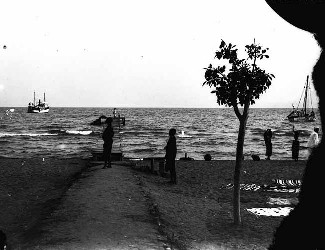
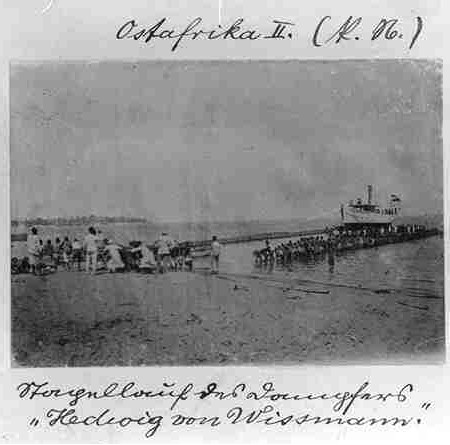
On August 12, the first zug (platoon) of the Abteilung Moewe arrived at Kigoma. Commanded by Oberleutnant zur See Horn, the 30 sailors immediately rearmed and finished repairing the German lake steamer Hedwig von Wissmann (nearly 60 tons) with the four 3.7cm revolver guns from the Moewe . They then prepared the port of Kigoma for an expected Belgian seaborne assault from across the lake.
Lake Tanganyika is the second largest lake in Africa with 12,700 square miles of water in area, and with a depth of 4,700 feet it is the deepest lake in Africa. It is also the longest lake in the world spanning 420 miles north to south, although it is only ten to thirty miles wide. The Lukuga River is the only outlet, and is usually silted up. This is important in understanding the challenge facing both the Germans and Belgians. Steamers were very valuable military (and economic) assets on the African lakes. A German expedition of 5,000 porters under the command of Otto von Schloifer had transported the 60-ton steamer Hedwig von Wissmann in parts to Lake Tanganyika, where it was assembled and operational from September 1900 onwards. While a dhow needed six weeks to cross the lake from north to south, a steamer could make the same journey in six days. When in military service, the Hedwig von Wissmann is recorded towing up to 8 dhows at a time thus making their supply and troop transport much more efficient. The rearmed Hedwig von Wissmann could nevertheless only do six to seven miles an hour.
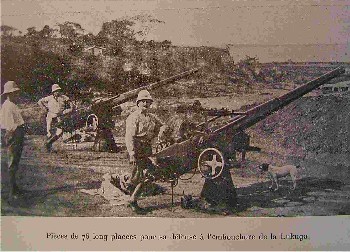
On the night of August 14/15, Horn initiated the first violation of the Congo territory near Uvira when he sent a landing party to destroy a telegraph line. Horn continued his patrol sinking a number of native canoes on the pretext that these canoes were "intended for the conveyance of troops," and on August 25 Oberleutnant Horn finally spotted the Alexandre Delcommune near the shore at Mpala. The alternative story is that the Hedwig was warned off by the Belgians as it passed Moliro on August 21, and that Horn learned of the location of the Delcommune from the Belgian askari sent with the message. It was also alleged that the Belgians fired the first shot of the campaign on August 22. Regardless of how the Delcommune was located, the Hedwig moved immediately to engage, but the faster Delcommune refused combat and fled to the protection of the 7.5mm and 4.7mm shore guns at the mouth of the Lukuga River.
Undaunted by his inferior weapons and speed, Horn immediately engaged the Belgian guns, and concentrated his fire on the Delcommune. The battle continued for two hours and the Hedwig succeeded in inflicting a hit on the Delcommune's boiler and funnel. The crew of the Delcommune grounded the steamer, and satisfied that he had been successful, Horn withdrew. The Hedwig had suffered only one hit from enemy shell fire, a hole in the stern flag. This short action prompted a telegraphed message from von Lettow-Vorbeck, "Thanks and congratulations to the brave Moewe ."
The consequence of the Hedwig's patrol was for the Belgian government to order M. Tombuer, Inspecteur d'Etat officiating as Vice-Governor of the Katanga Province, to "take all military measures for the defence of Belgian territory. Tombuer was also authorized to cooperate fully with the British. This amounted to a renunciation of the neutrality of the Congo.
Tombuer had a task set before him. In 1914, the armed forces in the Belgian Congo amounted to little more than gendarmerie. It consisted of 25 independent companies scattered throughout the colony, a Compagnie Cycliste, and what was thought to be a single artillery company located at Shinkakasa, but there may have been five Compagnie Artillerie located at Elizabethville. As Tombuer attempted to create a military force, the Belgian government in the Congo communicated with the British authorities in Uganda attempting to create a cooperative effort against the Germans throughout September and October. On October 27, M. Henry and Captain E. S. Grogan, Assistant Intelligence officer in Uganda, met at Kibati. It was a cordial meeting and both parties found themselves in agreement, but the meeting was concluded that no concerted action was immediately possible.
If the Belgians and British were lethargic in their reactions, Oberstleutnant von Lettow-Vorbeck was much more energetic. Deciding not to incorporate the Abteilung Moewe into the Indian Ocean coastal defensive forces, he ordered Kapitaen zur See Gustav Zimmer and the rest of the Abteilung to Lake Tanganyika and appointed Zimmer overall commander of Lake Tanganyika and Lake Kivu on August 26. This included the Ruanda District under Hauptmann Wintgens and the Urundi District under Hauptmann Schimmer, as well as Udjidi and Bismarckburg. Zimmer arrived at Kigoma with Abteilung Moewe on August 30 and immediately set about improving the defenses on the western border, including Kigoma.
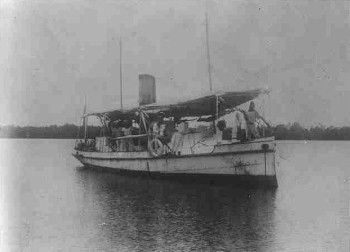

Zimmer chose Kigoma as his headquarters for military command of the ground and naval operations due to its good communications, very good harbor, and its connection with the "Mittellandbahn" (Middle Railroad). It was here that he collected all of the useable equipment and provisions that had been salvaged from the Moewe before it was sunk. The most valuable items included the steam boats of the Moewe and a few Schutztruppe and government boats that were found in the Daressalam harbor, including the petrolboat Peter, the motorboat Benz of the German East Africa Railway Company and the 20-ton steamer Kingani. The latter had only been made available after a serious confrontation with the civil authorities of the colony. Hauptmann von Kornatzki finally had to occupy the Bezirksamt (Government headquarter) of Daressalam with his askaris to break the resistance by Vice-Governor (Regierungsrat) Humann.
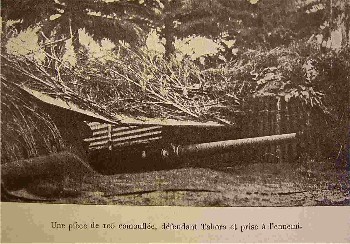 When the 8.8 cm guns arrived at Kigoma, it was discovered that they were too large to mount on the Hedwig, so a wooden raft was built during September using thick boards put together in three levels. Both of the 8.8 cm guns were then mounted on the raft. The armament of the German steamers on the lake changed a couple of times during the war and as a result there is some confusion among modern authors with regard to the guns they carried in each of the engagements.
When the 8.8 cm guns arrived at Kigoma, it was discovered that they were too large to mount on the Hedwig, so a wooden raft was built during September using thick boards put together in three levels. Both of the 8.8 cm guns were then mounted on the raft. The armament of the German steamers on the lake changed a couple of times during the war and as a result there is some confusion among modern authors with regard to the guns they carried in each of the engagements.
Meanwhile, Horn was actively patrolling with the Hedwig von Wissmann and discovered that the Alexandre Delcommune had been towed away. This was a serious situation for Zimmer, and when he received native rumors that the Delcommune might be at Baraka, Zimmer took personal command of the Hedwig and steamed with the new raft to that port. Towing the raft slowed the speed of the Hedwig to 1.8 mile per hour in calm water. The Hedwig was accompanied by the motorboat Peter of the "Gesellschaft fur Schlaftkrankheitsbekampfung" (Society for the Fight Against Sleeping Sickness) under Materialienverwalter (Administrator of supply depot) Kunz. Kunz sped ahead of the slower Hedwig and shortly came under fire from the Belgian guns at Baraka. At that time, Kunz's motorboat became still in the water. The engine failed at that time, but it was restarted, and Kunz sped away. Meanswhile, another motorboat scouted south of Baraka. The Hedwig finally arrived and shelled Baraka with 30 precious shells from the 8.8 cm guns before withdrawing causing some damage.

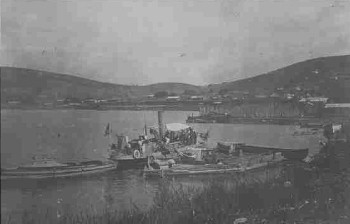
Ironically, on the way back to port, Horn discovered from the motorboat that had scouted to the south that the Delcommune was not in Baraka, but had been sighted at Mtoa Albertville. The Belgian steamer was on shore and being repaired. Zimmer decided to steam to that location immediately with the intent to capture and tow the Belgian steamer to a German port, or failing that attempt to destroy it before it could be repaired.
Zimmer decided that the Delcommune could not be captured as it was defended by a Force Public company from Albertville. So, instead of trying to capture the steamer, or trying to shell it, Zimmer came up with a daring plan.
On the night of October 8/9, Oberleutnant Horn landed out of sight of the Belgian sentries with a small party. They made their way through the darkness to within a few yards of the Delcommune's derelict hulk before they were discovered. They ran to the steamer, which was protected by a wall of sand and other materials against the waves of the lake, and mechanic Matuscek and Vizefeldwebel Knaak set two boxes of dynamite in the engine room and ignited the fuses. The party had brought more boxes of dynamite, but there was only time to set the two due to the intensity of fire coming from the Belgian askaris. The Belgians recovered from their initial surprise and forced the German landing party to retreat. Then, the sky lit up with the explosion of the dynamite.
The next night Oberleutnant zur See Odebrecht landed with seven chosen men about one kilometer north of the Delcommune's position to observe the damage that had been done earlier. The party discovered much to their disappointment that only a few plates had been blown off and that the damage was superficial. This time the Belgian askaris were more alert and immediately began firing at the Germans and tried to surround the party of commandos. Odebrecht ordered the sailors to fire as quickly as they could to make the askaris think that there was a larger party. This caused the askaris to slow down their advance allowing the Germans to escape. The group reached the Hedwig by swimming to it later in the evening. The Germans were amused when they intercepted a wireless message stating that the Belgians thought that they had been attacked by 100 Germans. Odebrecht's ruse had worked.
Zimmer had failed to destroy the Delcommune, but it did not dampen his spirits. He turned his attention to the Belgian garrison at Uwira at the northern end of the lake. He planned a combined operation using the Hedwig and gun raft) and detachments from Abteilung Moewe and Abteilung Urundi under Hauptmann Schimmer. The plan was for the Moewe to stay in a position three kilometers east of Uwira while the ground elements advanced in a northern direction on shore. Uwira had fortified terraces on the slope of a hill protected by rifle pits and barbed wire. It also had four old 7 cm guns.
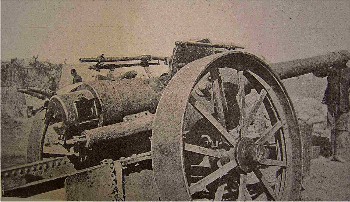

Zimmer set off on August 19 and bombarded the Belgian garrison while the ground attack was called off. The Germans observed an ammunition bunker exploding, but decided to head for Mtoa Alberville. Bad weather caused some delay and the Germans did not reach Mtoa Albertville until the 23rd. When the Germans arrived, the Delcommune had disappeared again. Zimmer had taken command of the gun raft and turned command of the Hedwig to Horn.
As the Hedwig approached the southern edge of the port the Belgians opened fire with two 7.6 cm guns which was a surprise to the Germans. Zimmer replied with eight shells from the 8.8 cm guns. This had the effect of destroying one of the Belgian guns and temporarily silencing the other. Zimmer then ordered the Hedwig to open fire with two 4.7 cm guns that had been brought into position and had opened fire. Horn's gunners quickly silenced one of the Belgian guns, and scored hits close enough to flip the other gun over twice. The Belgian gunners proved themselves up to the battle and kept the gun in action.
While the battle between the Hedwig and the single Belgian gun continued, Zimmer discovered the Delcommune anchored near the shore. He ordered the 8.8 cm guns to begin firing at the Delcommune at the same time that he ordered Oberleutnant zur See Odebrecht to take a steamboat to attempt to tow it to deeper water. Luck was not with the Germans and the steamboat grounded in shallow water. The Belgian askaris saw the opportunity and began firing at the hapless boat. By the time that the steamboat was able to retreat it had been holed badly with rifle bullets and was leaking. The crew stuffed wooden sticks into the holes to stop the leaks. Fortunately the engine was not hit, but one shot bent the iron oar wounding Maschinistenmaat Dillmann in the thigh. He was the first casualty Zimmer had suffered since he took command.
The battle ended as the Hedwig steamed away with the wounded steamboat. The Hedwig had not suffered any significant damage and no casualties. Later the Germans would intercept another Belgian wireless message that the valiant Alexandre Delcommune had received 40 hits from 8.8 cm shells and was "completement detruit." With only one wounded sailor and about 78 rounds of 8.8 cm shells Zimmer was master of the lake.
The vigorous actions by Zimmer convinced the Belgians that they were confronted by 2000 Germans instead of about 200 ex-sailors and polizei askaris. Although the Belgians had nearly 1700 askaris north of Lake Tanganyika, they feared that removal of these troops to an offensive would threaten Uvira and the railway under construction to Lukuga. The Belgians were convinced by Zimmer's actions that no offensive action would be possible until the British could cooperate completely. On 10th November, the steamer Kingani was operational and reinforced the little fleet, at first equipped with only one of the 3.7cm revolver guns from the Hedwig von Wissmann.
By mid November, 1914, Kapitaen Zimmer appointed Kapitanleutnant Kendrick commander of a little fleet consisting of the Hewig von Wissmann (Oberleutnant zur See Horn) and the Kingani (Oberleutnant zur See Odebrecht). Kapitaenleutnant Kendrick's first mission was to steam south with the fleet to capture or sink two British lake steamers that were sitting derelict on the beaches of the southern part of Lake Tanganyika. The first lake steamer to be destroyed was the Good News which had been sent to the lake by London Missionary Society in 1886, and was the first lake steamer on Lake Tanganyika. On 18 November, Kendrick found and destroyed the Good News together with two steel boats at Kituta, at the southern edge of the lake. On 19 November, Kendrick found the second steamer, Cecil Rhodes, at Kasakalawe. In a nearby depot he captured 230 kilometers of valuable telegraph wire and a stock of iron telegraph poles (some sources state that 150km of wire were captured). When Kendrick attempted to tow Rhodes into deeper water on the next day, an intense firefight ensued resulting in the destruction of the British lake steamer. The captured telegraph equipment was first transported to Bismarckburg. In early December, it was brought on dhows to Kigoma and used to build a telegraph line from Iringa to Neu-Langenburg.
December 1914 and January 1915 passed in patrols and raids for the German lake steamers disrupting land traffic and forcing the Belgians to concentrate on fortifying their positions. Leutnant zur See d. R. Ungerer became a noted raider dedicated to dismantling the Belgian telegraph line along the coast. However, by February 1, 1915 there were indicators that things were changing on the Belgian Congo side of the lake. On that date, Zimmer accompanied a raid by the Hedwig. During that raid, the Hedwig disbursed a Belgian column with a single 3.7 cm shell. Zimmer ordered a landing party of eight sailors led by Vizesteuermann Edel to retrieve the loads that had been dropped. This appears to have been a trap as the landing party was attacked by an estimated 100 Belgian askaris as the Germans attempted to escape with the supplies. As two German sailors rowed the captured supplies to the Hedwig, the remaining seven sailors held off the Belgian attack supported by a revolver gun from the Hedwig. The Hedwig only had four men aboard at the time of the ambush.
One day later, the Hedwig arrived at Lukuga. Again Zimmer was ambushed by two Belgian 76mm guns located 180 meters above the town on high hills. This time, unlike October of the year before, the Belgian gunners were much better in their marksmanship. Only by luck the Hedwig was able to escape the "Langbasismessung" firing technique used by the Belgian gunners. As the Hedwig zig-zagged out of range, the 40 shells fired at her missed by only a few meters. One shell exploded close enough to set a tent on the deck afire.
A side result of the "battle" occurred as a result of the enthusiasm of the German crew who cheered the incoming rounds from the sun deck led by Obermaschinistenmaat Strehlke. With each round, the sailors shouted "Hurra" and waved their hats. This peculiar behavior may have saved the Hedwig as wireless messages intercepted later indicated that the Belgians thought that it meant that the Hedwig was sinking and were so convinced that they sent a company of askari to pick up the survivors. This caused the headquarters at Kigomi some anxious moments that were relieved when the Hedwig steamed unharmed into Bismarckburg two days later.
There was one last chance for a great raid. The Ba-HoloHolo tribe was disposed toward the Germans and provided a number of spies. Zimmer learned from the spies that the Belgians had a weak garrison of 30 men and a machinegun at Tembwe. A raiding party composed of the Hedwig (Leutnant Ungerer) and 35 askaris and five Germans from Bismarckburg led by Oberleutnant zur See Odebrecht set out on this raid. The Germans arrived near Tembwe on the night of February 26/27 and were advised by spies that there was another small Belgian post about an hour to the north. Vizefeldwebel von Stosch landed with nine askaris near the second post, while the main force of five Germans and 25 askaris under Odebrecht landed at Tembwe.
The main force entered the Belgian defenses led by a spy at dawn. However, the surprise attack failed because the defenders had been warned and opened fire on the Germans and askaris with rifle and machinegun fire. Odebrecht knew that his askari could not endure the fire of the machinegun armed enemy, so he did the unthinkable that always marked the elan of the German askaris. He ordered that the entrenched enemy be stormed with bayonet. The German askaris overran the machinegun position, killed the Belgian Lieutenant and scattered the defending askari. A few of the Belgian askari attempted to form pockets of resistance, but these were dispersed when Leutnant Ungerer called in artillery support from the Hedwig.
Fourteen Belgian askari bodies were counted on the field, and there were thought to be many wounded. The raid acquired the machinegun, the rifles from the dead, supplies, one captured askari, and remarkably one British prisoner. When the Hedwig picked up the Stosch detachment, it was found that Stosch had succeeded in killing four and wounding two Belgian askaris out of the garrison of ten men. This had been the bloodiest raid to this date as the Germans lost one askari killed, two askeris wounded, and one German, Obermatrose Strahlendorf, mortally wounded. Strahlendorf was an original member of the Moewe crew and an oarsman on the Hedwig.
The Kingani was active during this time under the command of Oberleutnant zur See Brocks. The Kingani shelled an entrenched Belgian position of approximately 160 askaris at Kibanga on March 11. Then, on March 14 the Kingani was ordered to patrol the Belgian coast between Baraka and Uwira as a diversionary action for a major raid by the Hedwig. The Hedwig, with the gun raft, under Kapitaenleutnant d.R. Jantzen, on that date shelled Baraka while a force under Oberleutnant zur See Siebel landed on Ubwari Island to capture a former German askari who was serving as Sultan under Belgian rule. The raid failed "due to the carelessness of the natives." It is recorded that on that occasion there was only one 8.8cm gun on the gun raft. The second gun had been temporarily transported to the coast to equip the captured steamer Adjutant in the Rufiji Delta.
In March, 1915, the Belgians began hanging many BaHoloHolo who they suspected of being subversives or spies. Zimmer noted that the natives had been removed from the area, but he seems oblivious to the hangings. This was only one of the indicators that Zimmer should have noted. The Tombuer reformed Force Public was being fed into the field and being "blooded" for the anticipated Belgian offensive. Zimmer had been ambushed twice, and operations that would have been bloodless in 1914 were more difficult. Although he could not know that the British and Belgians were moving toward a cooperative effort to be facilitated by British Brigadier General Malleson from Uganda, that the Belgians and British were cooperating should have been evident by the capture of the British prisoner at Tembwe.
Ironically, both the intended cooperative northern offensive advocated by Malleson and Henry, and the cooperative southern offensive advocated by Belgian Lieutenant Colonel Molitor to divert German attention from the primary northern offensive were predicated upon wresting control of Lake Tanganyika from the Germans. To accomplish this, Colonel Tombuer continued to press the Belgian government that this should be a Belgian task and not a British task. The ultimate political result would be that Belgium would control Ruanda and Lake Tanganyika.
Zimmer noted that there was much activity at Abercorn at the beginning of 1915, but he had no idea of the reason for the activity. In January 1915 the Chiradzulu district rose in rebellion unrelated to the war. The British K.A.R. depot at Zomba and local Europeans were reinforced by the dispatch from Karonga of a double company ("F" and "H"), 1 K.A.R. with a machinegun and a 7pdr, under Captain H. G. Collins was landed at Fort Johnston and put down the rebellion.
This minor affair prompted the redeployment of German askari companies from Daressalam, Tabora, and Muansa to Kigoma in April. All of the available German steamers, steamboats, and dhows were employed in transporting these troops using Lake Tanganyika to Bismarckburg. It was the "Molitor Plan" by accident.
In March, 1915 Zimmer learned, according to his memoirs, that a British naval expedition was on its way to Lukuga, consisting of three British officers, 35 men, and two motorboats. At the same time, he learned that the Belgians were building a steamer of 1200 tons (the Baron Dhanis). Zimmer was more concerned about locating the Belgian ship-yard than the British expedition.
This is interesting because the British believed that this effort was "dispatched in utmost secrecy from England." Clearly the British accomplished this epic task to supercede Tombuer's plan for Belgian dominance of Lake Tanganyika. The British Admiralty substantiated the plan as "determined to treat these waters as an outlying sea within the sphere of British naval power." It was a nice way of screwing the Belgians with their tactile agreement to allow British movement through the Belgian territory.
In 1941, Horndern noted that the story of the journey of the Mimi and Toutou was well known, and since then, the story has found print in multiple texts and magazines. Basically, a big game hunter named John R. Lee came up with the idea of transporting two large motorboats from England to Cape Town, and then to transport these along the railroad to Elizabethville (Lubumbashi). The boats would then continue by rail to Jadotville where the rail ended. The last 120 miles would consist of the boats being dragged in a trailer to Sankisia where they would be loaded on a train and carried fifteen miles to Bukama on the Lualaba River. The boats would then be floated down the Luabala River to Kabalo. From there the last 175 miles would be by rail to Lukuga on the shore of Lake Tanganyika.
Zimmer was blinded by the lack of native informants, and so he sent out the Hedwig and Kingani to find where the Belgian ship was being built. The scouting missions failed to bring back any information concerning enemy ships. Oberleutnant zur See Odebrecht landed one night directly in front of an "enemy" position and identified an 80 meter long shipway on the shore in a very early stage of construction. Both Odebrecht and Oberleutnant zur See Rosenthal attempted to monitor the progress of this construction, but failed.

A bright moment occurred with the completion of the 1200 ton steamer Graf von Goetzen in early June 1915 at the shipyard at Kigoma. The 67 meter long and 10 meter wide Goetzen had a crew of 40 men and could transport up to 1000 men. A sister ship of the Goetzen, the Rechenberg, had also been ordered from Germany but had not yet been delivered when the war broke out. The Goetzen was first equipped with the remaining 8.8cm gun from the gun raft and two 3.7cm revolver guns from the Hedwig von Wissmann. The Graf von Goetzen could steam at eight miles an hour. The armament of the Hedwig von Wissmann was also changed on that occasion. It now carried a British 47mm gun at the bow that had been captured in the Rufiji delta and one 3.7cm revolver gun at the stern. The loss of the S.M. S. Koenigsberg in the Rufiji Delta provided a reinforcement of two 10,5 cm naval guns in July. From August onwards, Graf von Goetzen carried a 10,5cm bow gun, a 8.8cm stern gun and a 3.7cm revolver gun on the midship. The second Koenigsberg gun supplemented the defenses of Kigoma. The Graf von Goetzen now really had the potential to be the "terror of the lake."
Belgian Colonel Tombuer established three battalions of his "new Force Pubic" (8e, 9e, 10e) with the idea to conquer Ruanda. As before, Zimmer's lake steamer fleet was called upon to transport six askari companies from Kigoma to Usumbara during September. The ships also supported the German counter-offensive by actions along the Belgian coast between Baraka and Uwira. Oberleutnant zur See Rosenthal once again attacked Belgian telegraph lines and repair detachments with a series of successful raids.
Zimmer was increasingly blinded, but his officers continued to attempt to gain intelligence as to the situation. Oberleutnant zur See Odebrecht attempted to destroy several boats congregatd on the Lukuga River one night. Odebrecht entered the river in a "dinghy" boat, but failed. Obermatrose Muller and Oberleutnant zur See Rosenthal attempted to disguise themselves as natives to scout Kalemi, but failed. Rosenthal later attempted to land directly at the shipway that had been identified earlier only to be driven away. And on another occasion, an enemy boat crewed by some Belgian askaris and other natives were captured, but the prisoners could not provide any important information.
Rosenthal actually located the Mimi and Toutou on December 3, 1915. It took three tries. On December 1, he got within 200 meters of Lukuga at dawn aboard the Hedwig. The Hedwig only escaped the defensive fire from two 76mm and two 105mm guns by luck. The following night, Rosenthal attempted to swim to the shore and got within fifty meters of the causeway before the Belgian sentries began firing at him. On the third night, Rosenthal attempted the same swim, this time carrying a corkvest. This time he saw the two British vessels, but when he swam back to the Hedwig, he couldn't find it, although the Hedwig continued to send signals in the dark of the night. At dawn he watched the Hedwig sailing away and he swam to shore where he hid until he was captured by Belgian askaris. What a time! Rosenthal carried his boots, shirt, trousers, and a headgear, but no weapon. When captured, he presented himself as a German officer, but made no effort to defend himself by taking a firearm.
Rosenthal's story did not end there. He was willing to risk his life to convey what he had discovered to Zimmer. He was able to gain the confidence of a British officer to send a message to Kigoma requesting his personal belongings. In urine, he sent a secret message on the back of the page of the letter detailing his observations. Unfortunately, Zimmer did not receive the letter until February 1916 when it was too late. Generalleutnant Wahle, since October 1915, the over all military commander of the western part of the colony ("Westbefehlshaber"), mentions in his memoirs that Rosenthals letter nevertheless contained some valuable pieces of information regarding the upcoming Belgian land offensive. Following Wahle's account, the letter was so confusing and the list of Rosenthal's personal belongings so strange that all staff officers present were convinced that it contained some kind of secret message. After many attempts to combine letters, a photogragh was taken which finally revealed the message written in urine. Brave Oberleutnant zur See Job Rosenthal was not allowed to return to Germany from his war prison until February, 1920.
The activity that Zimmer was concerned about began at the end of October 1915 and continued for two months as a safe harbor was built to protect the light British boats from the heavy waves of the lake. Eccentric British Commander G. B. Spicer-Simpson weathered his own dangerous waves in working with the Belgians. Commandant (Major) Stringhlamber (senior Belgian officer at Lukuga) was not happy with the arrival of Spicer-Simpson since the Belgians had not expected the British to be successful in transporting the boats, and had determined that if the British were successful, the Belgians would command the British expedition on the lake. Spicer-Simpson, in his skirt, made short work of any Belgian attempts to contest command by simply pointing out that his rank was one grade above Stringhlamber.
As storms lashed the lake in the first two weeks of December, Oberstleutnant von Lettow-Vorbeck sent a group of experienced German raiders to Kigoma under the command of Korvettenkapitan a.D. Schoenfeld. Schoenfeld had been successful in blowing up several British trains on the Mombasa-Nairobi Railroad, and it was hoped that these experienced raiders would locate whatever was being hidden by the Belgians and destroy it. To accomplish this task, Schoenfeld was given command of the Kingani.
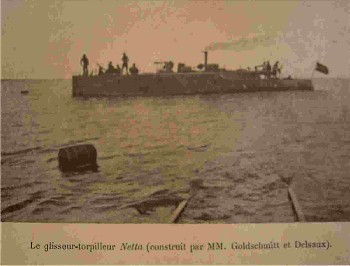
The Kingani was on patrol looking for what had already happened. On December 22 the British Toutou had been brought out of hiding, and the Mimi was launched the next day. On Christmas Day, both boats had their trials and fired one round each. So, when the Kingani was sighted only twenty miles from the British motorboat's lair, Spicer-Simpson ordered both boats readied for the first battle for Lake Tanganyika. Lieutenant Arthur Darville Dudley was given command of the Toutou and Spicer-Simpson took personal command of the Mimi. Out into the choppy lake the two British launches sped, followed by the Belgian motorboat Netta. The Netta was ordered to stay out of the fight in order to pick up survivors should one or both of the British boats had to be abandoned.
As the British launches moved to cut the Kingani off from retreating, things became interesting. According to Farwell, Leutnant zur See d. R. Junge shouted when he saw the British boats, "Die Englander sind hier!" and swung to port. At this moment accounts diverge. According to Farwell, the Kingani's armament consisted of a 6pdr mounted on the fore-deck that was heavier than the 3pdrs on the Mimi and Toutou. According to Zimmer, who should have known, the Kingani was armed with a 3.7 cm gun while the Britsh were armed with 76mm guns. Regarding the battle, Farwell provides a stirring account of the Kingani firing at the Mimi before it was close enough to reply. Then, somehow, according to Farwell, the two British launches "came within 2,000 yards of the Kingani and were able to return the German fire, [although] this brought the British within rifle and machinegun range." Suddenly the Kingani's fore-deck "exploded in flames," her colors were hauled down and "someone was seen waving a white cloth." Then, the Mimi rammed the crippled Kingani.
Zimmer provides a different account of the battle. The Kingani was too slow to escape the British launches, and she was too lightly armed to reply to the rounds that were sent into her. According to Zimmer "the British stayed outside of the range of the Kingani's gun (2400 meters) and could direct their fire carefully and without haste." The first hit on the Kingani killed Leutnant zur See d.R. Junge (commanding the Kingani) and a German NCO. The second hit killed Vizesteuermann d.R. Penning, and the third hit killed two men of the crew. This left only two crewmen alive who were captured before they could blow the Kingani up.
Regardless of which story, or combination of stories, one might prefer, the Kingani was ambushed successfully by the British and towed to shallow water where Horndern states she sank. Farwell provides a graphic account of the carnage aboard the Kingani, indicating that the war had taken on a "Heart of Darkness" attribute, but more importantly he lists three Germans and eight African deck hands and servants. Only one of the Germans is identified as part of the crew. One can hypothesize that the other two were part of the Schoenfeld detachment. The failure of this raider contingent prompted the withdrawal of the unit on December 27.
Zimmer was still blind as to the situation on the lake. The few reliable native spies that remained, probably in British employment, reported that the Kingani had been sunk by Belgian shore batteries. They offered as proof that the funnel of the Kingani could be seen from the shore. Unfortunate as the loss of Kingani might have been, it did relieve Zimmer of the interference caused by the Schoenfeld contingent. Zimmer was still master of Lake Tanganyika.
Early in February Zimmer received information from "spies" that there was intensive Belgian boat traffic on the lake during the nights. To verify the incredible information that the Kingani had been sunk, and that the Belgians were trafficking on the lake, Zimmer detached the Graf von Goetzen(Oberleutnant zur See Siebel), the Hedwig von Wissmann (Oberleutnant zur See Odebrecht), and a smaller steamboat to operate under Zimmer's command. To find out what had become of the Kingani, Zimmer sent out the Hedwig, with a steamboat to the settlement of Kungwestock at the German shore of the lake opposite Lukuga on February 8 to find the Kingani. The plan was for the Hedwig to leave Kungwestock and scout the site of the Kingani wreck and then return to Lukuga to join the Goetzencommanded by Zimmer personally by noon February 9 to start a combined operation against any naval threat.
Zimmer arrived upon the Goetzen at the meeting point, but the Hedwig did not arrive. Zimmer was notified by the crew of the steamboat that was left behind that they had heard gunfire from the direction of Lukuga between 9 and 11 o'clock. Zimmer steamed to the rescue, but could not find the Hedwig. He only erroneously learned later that the Hedwig had also fell victim to the Belgian shore batteries.
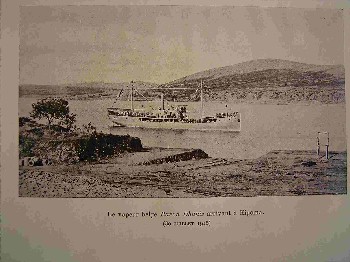
The German officers did not know that the wreck of the Kingani had been refloated and the engines put into order. That is why Zimmer could not find the verification of the wreck. The British mounted a 12pdr on the Kingani's fore-deck that had originally been intended for the Belgian Baron Dhanis, and a 3pdr on her aft-deck. The refitted Kingani was renamed by the British Fifi. Meanwhile, the Belgians had assembled the Baron Dhanis, and the wreck of the Alexandre del Commune had been patched together and rechristened the Venguer. The Venguer was given the Kingani's 3.7 cm gun. In addition, the Belgians had equipped a squarish ten-ton river barge that they named Dix Tonne armed with a 57 mm gun and a 47 mm gun paralleling the German raft with the 8.8 cm guns. The German officers also were unaware that the Belgian authorities and Spicer-Simpson had reached an agreement that the Belgians would control the shore defenses and the British would control all the Allied vessels on the lake.
On February 9, 1916, the Hedwig von Wissmann was sighted by the British traveling on almost the same path as the Kingani had fatefully traveled earlier scattering smaller Allied unarmed vessels that raced for the safety of the harbor. About 0745 the Hedwig sighted the British Fifi and Mimi motorboats with the Dix Tonne and an auxiliary boat steaming out of harbor to engage the Hedwig. Odebrecht must have thought that his steamer was equal to the task as he turned to meet the little boats. Odebrecht suddenly changed his mind and turned hard to port in an attempt to outrun the Britsh/Belgian flotilla at 0930. It may have been Odebrecht's plan to ambush the Allied fleet in reverse by drawing the Allied steamers to the meeting place with the Goetzen as had been previously planned. The Goetzen would have changed the course of the battle and the fate of the Hedwig. In a letter sent by Odebrecht to Otto Schloifer (the man who had built the Hedwig in September 1900), he justified his defeat by stating that he simply ran into a superior enemy force consisting of four vessels which were superior in speed and armament and which opened fire from a distance of 8.000 meters while his own guns had maximum ranges of only 3.000m and 2.500m respectively.
Spicer-Simpson commanding the slower Fifi sped forward to catch the Hedwig. He was soon out distanced by the faster Mimi commanded by Sub-Lieutenant A. E. Wainwright. Spicer-Simpson attempted to wave the Mimi off, but he was ignored by Wainwright. When the Mimi was three kilometers from the Hedwig, Odebrecht opened fire with the 4,7 cm gun mounted on her stern. The Mimi turned away and kept a distance of six kilometers with the Fifi. In this way the two British vessels cooperated to alternate firing and observing for each other. A couple of times Odebrecht turned in an attempt to bring his gun into action by bring the distance between the steamers to three kilometers which was the limit of the range of the gun. Spicer-Simpson and Wainwright in their faster boats were always able to keep a distance of six kilometers within the range of the 12 pounder gun on the Fifi. The Fifi had been fitted with a 12 pounder gun on January 15, 1916.
At 11:30, the Hedwig received the first hit. This was followed shortly after by a second hit in the steam boiler. As steam poured out and the oily wood caught fire, the "symbol of German dominance on Lake Tanganyika, was helpless as she could no longer be maneuvered. Even in this position, the British were unwilling to move closer fearing the Hedwig's reputation and her puny gun. Odebrecht could not see the Goetzen, so he gave the orders to abandon ship. The natives were given the ship's boat while the Germans were provided swimming vests. Oberleutnant zur See Odebrecht and Maschinistenmaat (engineer) Mewes were the last men to leave. Before they abandoned ship, they set charges to blow the heart out of the Hedwig so that she might not be captured. As they swam to safety, the charges detonated and the Hedwig von Wissmann sank with colors still flying.
After an hour the swimming, survivors were picked up by the British and Belgians. Farwell adds that the delay for the Fifi in rescuing the survivors occurred when Spicer-Simpson saw the Hedwig's flag locker floating in the water. Inside, he captured the first ever Imperial German naval ensign. Once all the German crew were ashore it was learned that the Hedwig had lost two German sailors and five native crew members killed and one sailor and two natives wounded. Oberleutnant Job Odebrecht was paroled and invited to dine with the British officers after being provided with a shirt and boots.
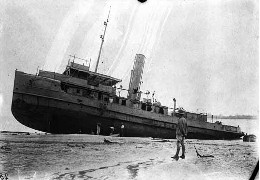

Zimmer was faced with a serious problem with the loss of both the Kingani and the Hedwig. This left only the Goetzen to contest the lake. He had applied for the transfer of the Wami (sister ship of the Kingani) before the sinking of the Hedwig. He had also requested the transfer of the 250 ton Adjutant (a British captured steamer). Both of these steamers were prviously deployed into the Rufigi Delta. The Wami arrived in Kigoma in February 1916 by rail, was armed with a 3.7 cm revolving gun, and was operational in March. The Adjutant was a more complicated matter. The Adjutant avoided the British blockade and escaped the Rufigi Delta to arrive in Daressalam. The steamer was too large to be transported by rail intact, so it was dismantled and railed in pieces to Kigoma. At Kigoma it was reassembled.
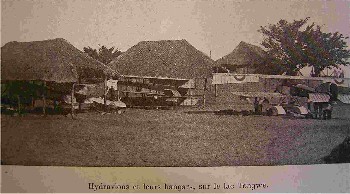
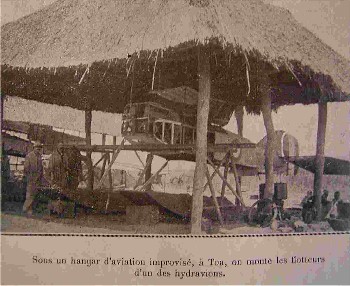
Meanwhile, the Kigoma defenses were improved as a land battle was expected. The Belgians established an airbase at a small lake nearby Albertville, where 250 65-pound and 700 16-pound bombs and four machineguns with 30,000 bullets were stockpiled for the airforce consisting of altogether four British Short seaplanes. The base was operational from 13 March 1916 onwards and starting on 2 June various bombing raids were launched against the port of Kigoma and the German steamers Goetzen and Adjutant, with the seaplanes usually carrying two 65-pound bombs each. The Belgian pilots claimed various hits on the Goetzen, but whether the bombs had any effect is a matter of conjecture. Zimmer comments that these planes "did not cause serious damage". The air raids certainly did have some effect on Zimmer and the Germans' morale.


In mid-May the Goetzen was stripped of its main armament (a 10.5 cm and a 8.8 cm gun) as these were needed by the Schutztruppe. Having only a 3.7 cm gun left, the Goetzen remained in port. Unable to defend itself against the Allied flotilla, it acted as a decoy armed with wooden dummy guns mounted on the bow and stern.
The stalemate on the lake had more to do with the refusal of Spicer-Simpson to engage the German fleet than to any practical reason. Ordered to Bismarckburg, Spicer-Simpson even refused to attack a group of unarmed German dhows transporting askaris. Meanwhile Tombuer's Brigade Nord moved forward, cut the rail line, and threatened Kigoma. On July 26, Zimmer ordered the Goetzen destroyed and evacuated Kigoma. The next day, the Wami, under the command of Steuermann Wettstein, transported the last detachment of askaris southwards to the mouth of the Malagarassi River unhindered by the frustrated British flotilla. It was only when the Wami had been scuttled that a British steamer opened fire on the sinking ship. This was the last action between the two small navies on Lake Tanganyika.
Kapitaen zur See Gustav Zimmer had stalled the Allies for almost two years with a motley few ships. Unlike most popular histories, these were not "pocket battleships" that roamed the lake with impunity. His only reinforcements were the Wami and Adjutant, but these arrived too late to impact the impending end. Oberstleutnant Paul von Lettow-Vorbeck had decided that the main effort of the German colony should rest upon the Schutztruppe by the time that the Wami and Adjutant were ready. In terms of manpower, Zimmer only received three officers (Oberleutnant zur See Freund, Beckmann, and Rosenthal), 50 sailors from the Koeningsberg crew, reserve officers Kapitaenleutnant Jantzen, Oberleutnant zur See Siebel, Leutnant zur See Ungerer, Vizesteuermann Edel, and forty sailors (Marinereservemannschaften) from the merchant ships of the Deutsche-Ostafrika Linie.
The early victories in 1914 may have influenced Zimmer's later actions as he might have felt too secure in his possession of the lake by 1915. Certainly, for a while, he received valuable information from native spies and Belgian wireless messages. However, by 1915, he should have been aware that these early advantages were disappearing. The Belgian askari began acting in a more proficient manner, the spies became more unreliable, and the wireless messages seemed to have dropped off completely. Zimmer seemed convinced that he was only opposed by the Belgians who were attempting to rebuild a flotilla to contest the lake, and the British appearance caught Zimmer by surprise.
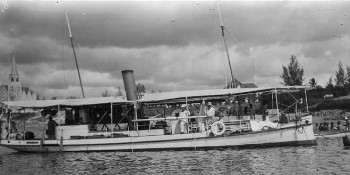
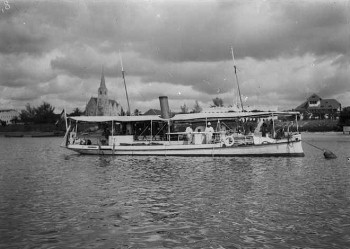
It is clear that the German superiority on the lake was predicated upon the Kingani and Hedwig, and when these steamers were lost, he seemed to have lost his former elan, in spite of the military hardware becoming available in the form of the steamers Goetzen, Adjutant and Wami. Had he paid more attention to the indicators, he might have kept his ships together by the end of 1915, rather than risking them in little scouting missions by single ships, he probably would have been more successful. When Zimmer failed to use his reinforcing steamers, partly due to v. Lettow-Vorbeck's orders to strip the steamers of their armament to use with the German schutztruppen, the lake fell to the Allied land operations rather than to naval operations. As predicted, so long as the Germans controlled the lake, the Allies feared land operations, but once the heart had been torn from the German naval superiority, the next step was to eliminate the German resistance on the western front using the overwhelming superiority of the Allied infantry companies.
Bibliography
Abbott, Peter. Armies in East Africa 1914 - 18,. Osprey Publishing, Great Britain,
2002.
Farwell, Byron. . The Great War in Africa (1914 - 1918), .W. W. Norton & Company,
New York USA, 1986.
Hordern, Charles. . Military Operations East Africa Aug. 1914 - Sept. 1916,. Battery
Press, Nashville, USA, 1990.
Lochner, Reinhard. Karl: . Kampf im Rufiji-Delta. Mnchen, 1987.
Schloifer, Otto. . Bana Uleia. Ein Lebenswerk in Afrika.. 3.Aufl. Berlin, 1943.
Sibley, J. R.. . Tanganyikan Guerrilla, East African Campaign 1914 - 18,. Ballantine
Books, New York, USA, 1971.
Stienon, Charles. . La Campagne Anglo-Belge de l'Afrique Orientale Allemande..
Berger-Levrault, Libraires-Editeurs, Paris, 1918.
Von Lettow-Vorbeck, Paul. . My Reminiscences of East Africa, .Battery Press, Nashville,
USA.
Wahle, Kurt. . Erinnerungen an meine Kriegsjahre in Deutsch-Ostafrika 1914-
1918..O.Ortsang., 1920.
Zimmer, Gustav. . Die "Moewe" - Abteilung auf dem Tanganjikasee in Deutsch-
Ostafrika 1914 - 1916, von Kapitaen zur See Gustav Zimmer, im
Militabefehlshaber am Tanganjikasee. .
Close Window To Return To The Table Of Contents